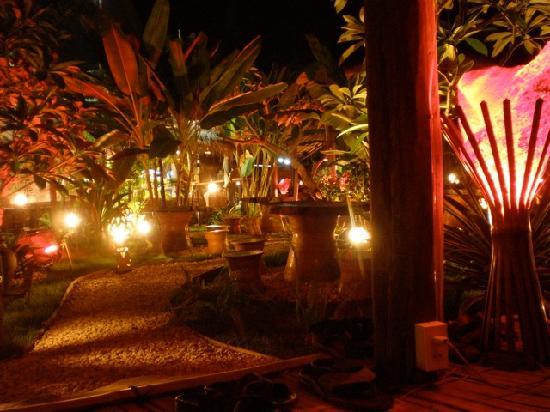So I went up to Luang Prabang in Northern Laos over the weekend.
 |
| Luang Prabang is saddled between the Mekong and the Nam Kahn Rivers |
The trip was a good one, and I do have a couple of stories to tell about it. Today, though, I'm just going to focus on the actual journey involved, because I think it's kind of interesting.
I started in Ban Thin and went up to Nong Khai, which is on the Thai side of the Frendship Bridge, a two kilometer bridge connecting Laos and Thailand. Vientiane, Laos' capital, is on the other side. One must go through a border crossing going either direction, and after the border crossing there are busses which shuttle travellers to the other side of the bridge.
In Vientiane I caught a bus up to Luang Prabang. It's about a nine hour busride through the mountains of the Laos countryside. The road is twisty, turny, steep and treacherous... really.
Fortunately, I reached my destination safely, albeit tired and cramped. The bus was a bed bus, which would be good if I was asian-sized, like the people it was intended for. As it was, though, I was about 20 cm taller than the bed, so I couldn't lie down straight.
 |
| I got in around 5:30 in the morning... welcome to Luang Prabang! |
This wouldn't have been two much of a problem, except the beds were pretty narrow... and I had a bedmate. The bus was actually pretty nice, but it just wasn't quite large enough for a
Farang like me.
 |
| Like I said, the bus was nice... it looks kind of space-agey in this picture |
 |
| It was just a little small for two people |
Taking a similar bus back from Luang Prabang would have been the fastest way to get back, but Thailand has a strange rule where it only awards 30-day visas to travellers arriving by air. Had I gone back by bus, I would have only received 15-days.
Because of this, I ended up taking a plane with Lao Airlines to Chiang Mai, one of Thailand's major cities, and another bus from Chiang Mai back to Ban Thin.
The plane was kind of neat- it was a smaller sized prop plane. I would have liked to tell more about how it flew, but I was so tired I passed out before we got into the air.
What I do remember is the stewardesses who were milling around the airport- each one was identical to the photo Lao Airlines used to advertise their service- they were all the same height, clad in blue, had perfect buns and a small flower in their hair. It was really actually quite uncanny how similar they all were.
 |
This photo doesn't quite do Ms. Stewardess justice
Also, 'stewardesses' is the longest English word one can type with just hte left hand. |
After a couple of hours in Chiang Mai (and a very relaxing massage), I took the bus back to Ban Thin. This one, thank goodness, had seats instead of beds... and I slept like a baby.





















